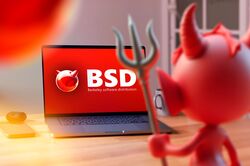BSD: What Is It, and How Is It Different From Linux?
Looking around at lesser-known operating systems, you've likely come across something called BSD, or FreeBSD. Both Linux and BSD are open source, Unix-like operating systems, but they're different. Here's what you need to know.
BSD Is Dead, Long Live BSD
Linux is a built-from-scratch facsimile of Unix, but BSD is actually descended from Unix. Unix is an operating system developed at Bell Labs in the late 1960s. When two of the Unix lead developers presented a paper at a conference in 1973, interested parties requested copies of their new OS.
Because of trade restrictions on AT&T—Bell’s parent company—Bell couldn’t treat Unix as a product with a revenue stream. To side-step the restrictions, Bell distributed copies of Unix as source code and a license, for a very small fee to cover shipping. The University of California, Berkeley was one of many Universities that took up that offer.
Ken Thompson, the chief architect of Unix, took a sabbatical from Bell to work as a visiting professor at Berkeley. Along with some graduate students, he worked on adding useful tools and important modifications. Bill Joy, a graduate student who later co-founded Sun Microsystems, made significant contributions, including virtual memory handling, and the TCP/IP networking stack.

